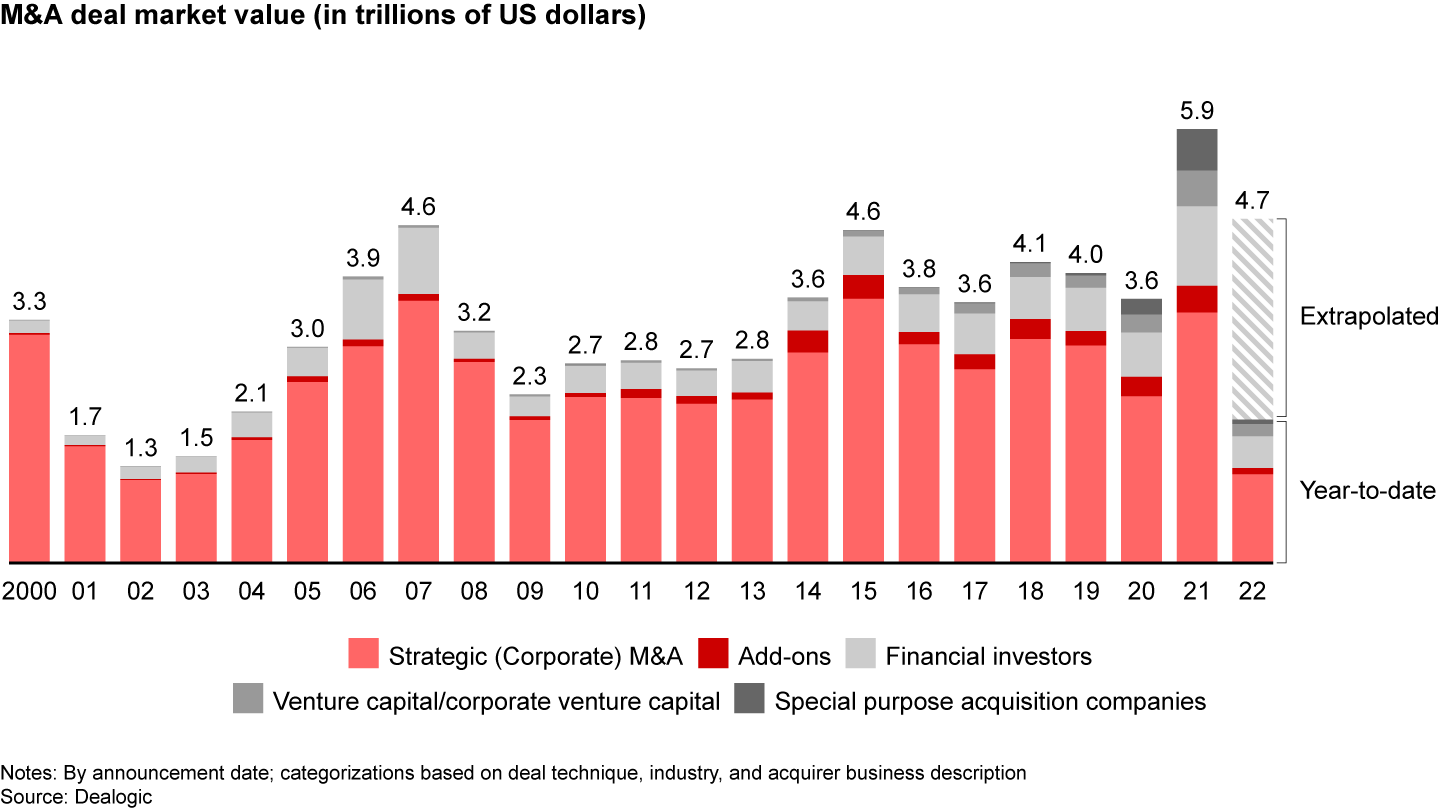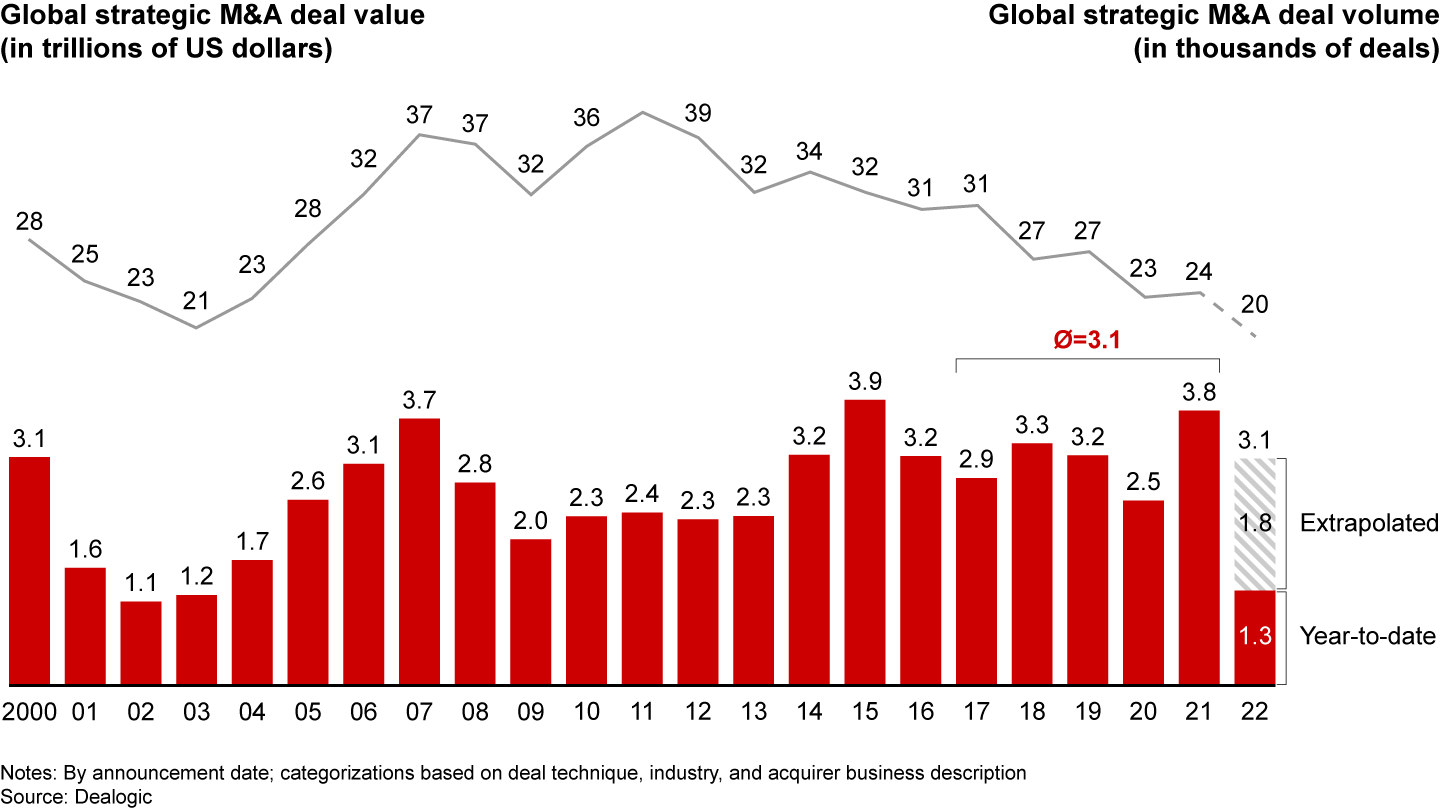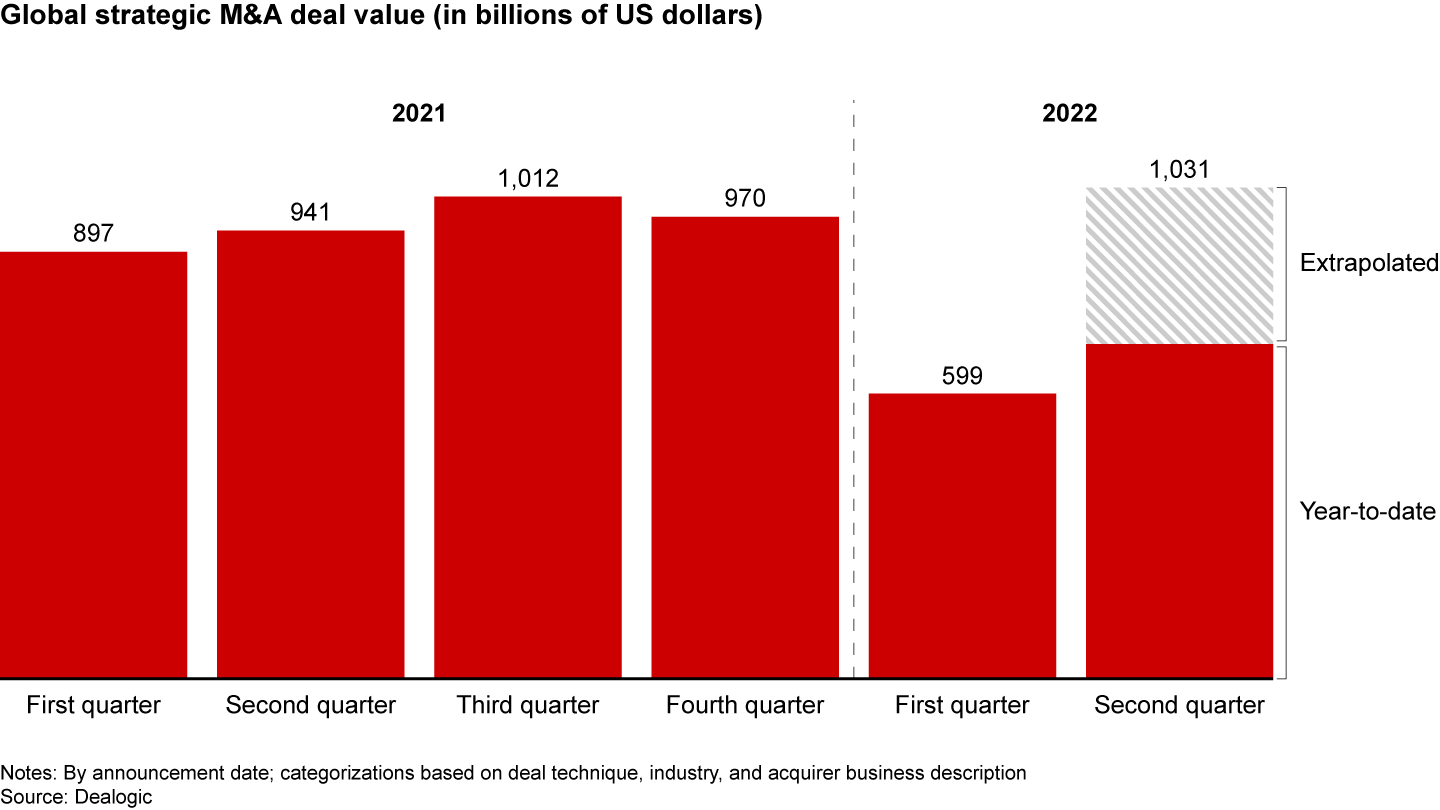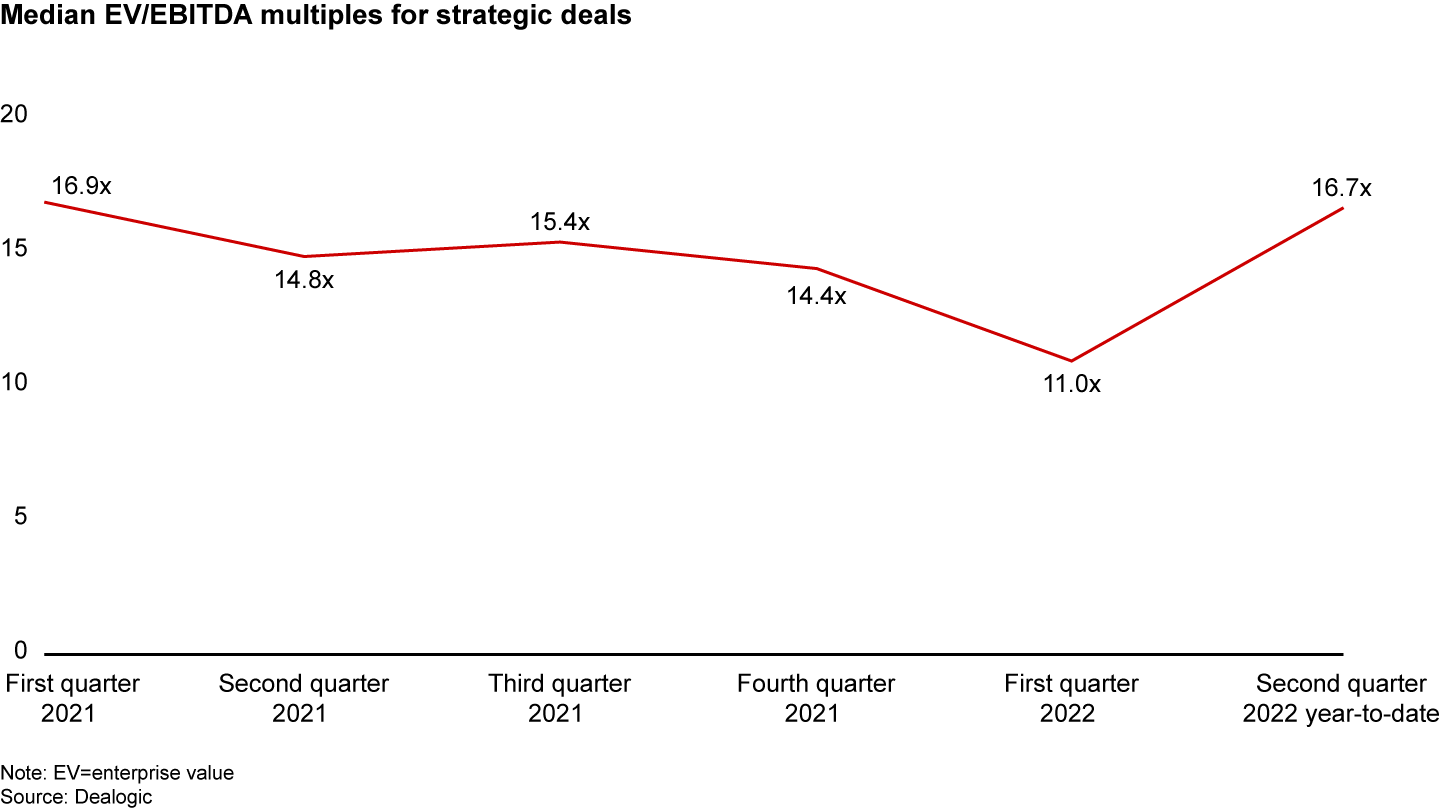Brief
 }
}
Executive Summary
- Turbulence has increased since we launched our Global M&A Report six months ago, and it will likely continue throughout the year.
- In the face of so much turmoil, it’s easy for corporate dealmakers to get conservative, yet the fundamentals exist for continued robust M&A activity.
- Based on the first five months’ performance, 2022 will likely reach $4.7 trillion in deal value by year-end, which would make it the second-best year on record.
- We believe that winning M&A teams will revise their M&A playbooks and deploy scenario planning that rigorously assesses the range of outcomes in five key areas of M&A uncertainty.
The world of M&A is far more complicated than it was in February 2022, when we released our fourth annual Global M&A Report. Inflation has soared. Governments around the world have raised interest rates, causing the cost of capital to increase. Supply chain issues have mounted while the war in Ukraine and heated geopolitical tensions from US-China relations have accelerated the retreat from globalism and cross-border deals.
Yet, amid all the disruption and risk, it’s easy to overlook the fact that the fundamentals still exist for robust M&A opportunities. We still live in a world where capital is generally available for deals. Most businesses still have strong cash flows and balance sheets. Meanwhile, private equity investors’ pockets are as deep as they’ve ever been. And we see that market leaders continue to do M&A, even during these turbulent times. For example, companies still turn to dealmaking to add new capabilities, as Broadcom did with its recently announced $61 billion acquisition of VMware. And industries still consolidate via scale M&A. For instance, Celanese’s $11 billion purchase of a majority stake in DuPont’s mobility and materials business is intended to strengthen the acquirer’s market position.
In 2021, total global deal value reached $5.9 trillion. So far this year, the M&A pace has cooled off, with aggregate deal value down by about 20%. That said, based on the first five months’ performance, 2022 could reach $4.7 trillion in deal value by year-end (see Figure 1), which would make it the second-best year on record.

In the first quarter of 2022, deal value totaled only $599 billion, a steep drop from fourth-quarter 2021’s $970 billion. The second quarter of 2022 brought with it a healthy recovery, however, with deal value totaling $702 billion in April and May (see Figures 2 and 3).


Recall that 2021 saw record deal valuations, with median enterprise value/EBITDA multiples at 15.4 times. At the extremes, tech asset prices soared to median multiples of 25 times and healthcare to 20 times. Looking deeper at 2022, valuations stumbled in the first quarter (down to 11 times enterprise value/EBITDA) only to rebound in the second quarter to 16.7 times (see Figure 4). We are in an era of unprecedented volatility.

What does this mean for companies trying to get deals done? The volatility we’ve witnessed in the first five months will likely continue throughout the year amid continuing inflation, recession fears, supply chain constraints, geopolitical tensions, increasing regulatory scrutiny, and Covid-19’s unpredictable path. In the face of so much turmoil, it is easy for corporate dealmakers to get conservative.
Bain’s research, however, has determined that the greatest competitive market shifts take place during times of turbulence. Companies that invest throughout the economic cycle have far superior returns than those that participate sporadically. Recession winners average 14% in compounded annual EBIT growth in the 13 years following a downturn compared with zero for recession losers, according to our study of nearly 3,900 companies. And as the winners adjust their corporate strategies for times of uncertainty, they continue to use M&A as one of the big levers to gain and strengthen their competitive advantage.
We see strong possibilities for companies willing to act. This must start with revising their M&A playbooks so that executives have a clear view of the full range of potential outcomes. Let us give a couple of examples: Margin expansion will be more challenging, so models must reflect a realistic assessment of the efficacy of price increases against likely input cost inflation. Likewise, being a low-cost producer will require greater investment in supply chain resiliency. In many cases, companies will need to derive revenue and growth in a more national, instead of global, scenario.
What’s also become more important is the ability to use leverage and the cost-of-capital advantages. Every model will be unique, but the range of new variables has grown significantly. The truth is that many executives have only experienced a low-cost-of-capital environment and will find it necessary to brush up on the deal model impact of the rising cost of capital.
We believe that winning M&A teams will deploy scenario planning that rigorously assesses the range of outcomes in five key areas of M&A uncertainty: the cost of capital, the availability of capital, the impact of inflation on margins, scope vs. scale deals, and regulation/spheres of influence. We’ll look at these one by one.
A doubling in the cost of capital can result in a halving of the net present value of future cash flows. Likewise, if the embedded weighted average cost of capital retreats by 50%, that could lead to a doubling of net present values. Out year cash flows are particularly sensitive to changes in the weighted average cost of capital, since growth becomes less valuable in a world of rising interest rates.
We have been writing for years about the superabundance of capital, which has largely resulted from a confluence of demographics, governmental policy, and international free flows of capital. We still are witnessing large quantities of dry powder and generally accommodative lending. Yet it is not hard to imagine a world in which savings rates decline (as older populations draw down retirement funds) and banking regulations and barriers to the free flow of capital across borders become more restrictive. This will not only further drive up the cost of capital; it may restrict the very availability of capital.
If companies cannot price up to match rising input costs (whether caused by elasticity issues or regulation), that will dampen their margins and valuations. Likewise, if companies have pricing power (particularly if commodity prices decline and consumer prices are sticky), we should see margins and valuations expand.
The long-term M&A trend has seen a shift toward scope and capability deals. That trend appears to have softened during the pandemic as many executives sought to further consolidate their industries. It is possible that a new conservatism will creep back into M&A, with a continued focus on industry consolidations and rollups. At the same time, scope and capability deals may return to the fore as executives wrestle to redefine their businesses in the face of generational disruptions (digital, twilight of the carbon economy, and redefined supply chains, for example).
A longer-term trend has been the decline in inter-regional M&A. If countries or blocs continue to raise barriers, it will continue to change the nature of M&A. On the other hand, if tensions ease, there may be a revival of cross-regional M&A deals.
Using scenario planning, deal teams can create modeling assumptions against both optimistic and pessimistic scenarios to stress test their investment and integration theses.
Finally, as M&A teams prepare to update their playbooks for a fraught environment, executive teams should consider answering these fundamental questions.
- How are we course correcting our strategy to take advantage of the opportunities during turbulence? What role should M&A play to reshape our portfolio/add new capabilities?
- Are we refreshing our M&A target lists to consider global economic volatility and relevant scenarios?
- Have we met with our bankers to update capital cost and availability assumptions?
- How are we adjusting our deal models given supply chain de-globalization and increasing inflation?
- In today’s tight talent environment, how are we going to ensure talent retention within our own organization as well as those being acquired?
Warren Buffett reminds all investors in assets that the time to be greedy is when others are fearful—and that the time to be fearful is when others are greedy. These are turbulent and scary times, but they also are times in which the shape of many industries will be set for the next several years.



